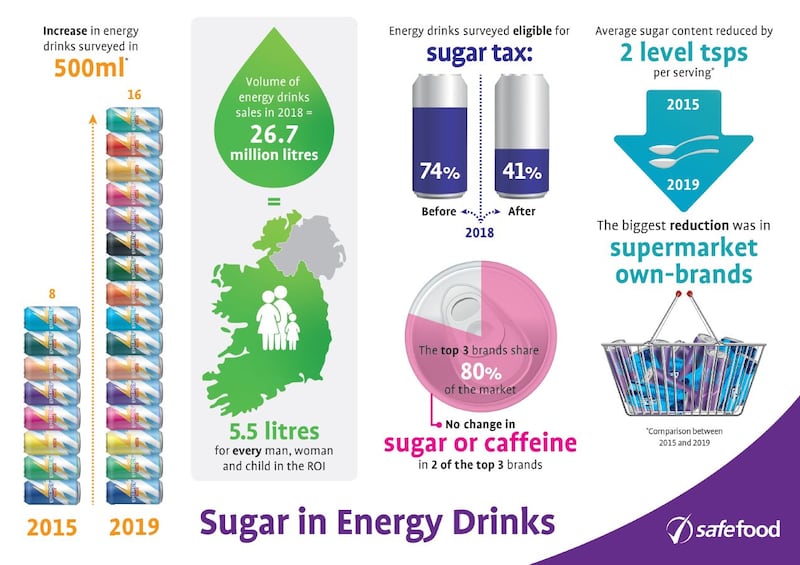The sugar content of some leading energy drinks for sale in Ireland has fallen as manufacturers look to avoid paying higher taxes. However, the size of many bottles and cans has doubled, offsetting the benefits of the reductions.
A survey published on Monday morning by the State’s food safety watchdog has revealed that the level of sugar in many energy drinks has fallen in response to the Sugar Sweetened Drinks Tax, but the Safefood research shows the percentage of such drinks sold in bigger serving sizes increasing dramatically.
It found that the average sugar content per serving of energy drinks has fallen by around two level teaspoons of sugar – from 31g to 23g – between 2015 and 2019.
Before the introduction of the sugar tax, 74 per cent of energy drinks on the Irish market were eligible for taxation as they contained at least 5g of sugar per 100ml. However, the 2019 survey data shows only 41 per cent of such drinks meet the tax threshold.
The snapshot survey said there had been a slight increase in the number of energy drink products for sale – up from 39 to 42 over recent years – but a much larger increase in the volume of drinks sold in larger servings.
In 2015 there were eight such products sold in 500ml containers compared with 16 in 2019. There was no change in the number of drinks sold in 250ml servings.
Minister for Health Simon Harris welcomed the reformulation of some drinks by manufacturers since the introduction of the sugar tax, and said it was "encouraging to see a significant reduction in sugar content in many products".

However, he pointed out that many such products remained high in sugar, and said he was “very concerned at the trend in increasing container sizes”.
Minister of State for Health Promotion Catherine Byrne said it was "very disappointing that the number of products on the market and the size of some containers has increased".
Retailers
The latest market research shows that between 2015 and 2018, there was a 3.4 per cent increase in the volume of energy drinks sold by retailers, with almost 27 million litres consumed here each year.
“Regular energy drinks are basically sugary drinks with added caffeine,” said Dr Marian O’Reilly, chief specialist in nutrition with Safefood.
“It’s a concern that they are cheap, readily available, in large containers and are marketed in a way that is appealing to young people.
“It is encouraging to see the fall in the average sugar content of these products. However, this is in contrast to caffeine contents appearing to have increased, with one serving of an energy drink contributing more caffeine than a standard espresso.” She said such drinks were unsuitable for children.














